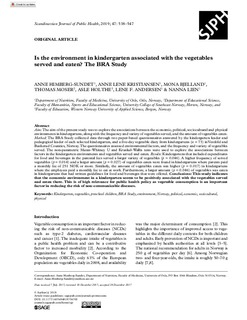| dc.contributor.author | Himberg-Sundet, Anne | |
| dc.contributor.author | Kristiansen, Anne Lene | |
| dc.contributor.author | Bjelland, Mona | |
| dc.contributor.author | Moser, Thomas | |
| dc.contributor.author | Holthe, Asle | |
| dc.contributor.author | Andersen, Lene Frost | |
| dc.contributor.author | Lien, Nanna | |
| dc.coverage.spatial | Norway | nb_NO |
| dc.date.accessioned | 2019-08-07T11:19:15Z | |
| dc.date.available | 2019-08-07T11:19:15Z | |
| dc.date.created | 2018-02-12T08:33:23Z | |
| dc.date.issued | 2017 | |
| dc.identifier.citation | Himberg-Sundet, A., Kristiansen, A. L., Bjelland, M., Moser, T., Holthe, A., Andersen, L. F., & Lien, N. (2018). Is the environment in kindergarten associated with the vegetables served and eaten? The BRA Study. Scandinavian Journal of Public Health, 47, 538-547. | nb_NO |
| dc.identifier.issn | 1403-4948 | |
| dc.identifier.uri | http://hdl.handle.net/11250/2607435 | |
| dc.description.abstract | Aim: The aim of the present study was to explore the associations between the economic, political, sociocultural and physical environments in kindergartens, along with the frequency and variety of vegetables served, and the amount of vegetables eaten. Method: The BRA Study collected data through two paper-based questionnaires answered by the kindergarten leader and pedagogical leader of each selected kindergarten, and a five-day vegetable diary from kindergartens (n = 73) in Vestfold and Buskerud Counties, Norway. The questionnaires assessed environmental factors, and the frequency and variety of vegetables served. The non-parametric Mann–Whitney U and Kruskal–Wallis tests were used to explore the associations between factors in the kindergarten environments and vegetables served and eaten. Results: Kindergartens that included expenditures for food and beverages in the parental fees served a larger variety of vegetables (p = 0.046). A higher frequency of served vegetables (p = 0.014) and a larger amount (p = 0.027) of vegetables eaten were found in kindergartens where parents paid a monthly fee of 251 NOK or more. Similarly, the amount of vegetables eaten was higher (p = 0.017) in kindergartens where the employees paid a monthly fee to eat at work. Furthermore, a larger amount (p = 0.046) of vegetables was eaten in kindergartens that had written guidelines for food and beverages that were offered. Conclusions: This study indicates that the economic environment in a kindergarten seems to be positively associated with the vegetables served and eaten there. This is of high relevance for public health policy as vegetable consumption is an important factor in reducing the risk of non-communicable diseases. | nb_NO |
| dc.language.iso | eng | nb_NO |
| dc.publisher | Sage | nb_NO |
| dc.rights | Navngivelse-Ikkekommersiell 4.0 Internasjonal | * |
| dc.rights.uri | http://creativecommons.org/licenses/by-nc/4.0/deed.no | * |
| dc.subject | kindergarten | nb_NO |
| dc.subject | vegetables | nb_NO |
| dc.subject | preschool children | nb_NO |
| dc.subject | BRA Study | nb_NO |
| dc.subject | environment | nb_NO |
| dc.subject | political | nb_NO |
| dc.subject | economic | nb_NO |
| dc.subject | sociocultural | nb_NO |
| dc.subject | physical | nb_NO |
| dc.title | Is the environment in kindergarten associated with the vegetables served and eaten? The BRA Study | nb_NO |
| dc.type | Journal article | nb_NO |
| dc.type | Peer reviewed | nb_NO |
| dc.description.version | publishedVersion | nb_NO |
| dc.rights.holder | © Author(s) 2018 | nb_NO |
| dc.source.pagenumber | 538–547 | nb_NO |
| dc.source.volume | 47 | nb_NO |
| dc.source.journal | Scandinavian Journal of Public Health | nb_NO |
| dc.source.issue | 5 | nb_NO |
| dc.identifier.cristin | 1564156 | |
| cristin.unitcode | 203,1,0,0 | |
| cristin.unitname | Avdeling for lærerutdanning - Bergen - Bergen | |
| cristin.ispublished | true | |
| cristin.fulltext | postprint | |
| cristin.qualitycode | 1 | |

